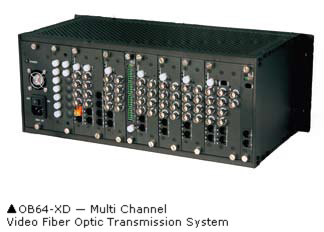OB Telecom, founded in Hangzhou, China, has reached its first 10 years. In 2000, a group of experts in digital video communications gathered to develop and produce digital video products. As a technology-driven company, OB Telecom plans to expand — not only in the Chinese market but overseas as well. A&S China Best Buys talks to OB Telecom’s team about the company’s past and future.
OB Telecom, founded in Hangzhou, China, has reached its first 10 years. In 2000, a group of experts in digital video communications gathered to develop and produce digital video products. As a technology-driven company, OB Telecom plans to expand — not only in the Chinese market but overseas as well. A&S China Best Buys talks to OB Telecom's team about the company's past and future.
OB Telecom was founded in 2000 from the Optical Fiber Communication Technology Research Laboratory in Zhejiang province, to offer digital video optical fiber transmission. In its first 10 years, OB Telecom reached several technology milestones. It produced its first digital encoded video fiber optic transceiver in 2000, followed by comprehensive transmission products combining video, Ethernet and telephone signals in 2001. Other developments include its digital encoded cascade video transmission system in 2003 and the first-generation VAR digital video integrated multiservice optical transmission and switching systems in 2005.
It developed the VAE digital video collection transmission in 2007 and second-generation VAR in 2008.
With more than 100 R&D personnel, the company is positioned to be a technology game-changer. “We have relied on innovation to move ahead,” said Tony Shi, General Manager at OB Telecom. “We entered the market in 2000, which is nearly three years ahead of most competitors. In 2002, we started manufacturing telecom transmission products for overseas sales, something no other company had at the time. From our technological background, we design a comprehensive product that would be able to do everything while reducing fiber optic bandwidth. Our R&D design gives us an edge in the industry.”
Quality Conquers Markets
For the past nine years, the company enjoyed stable development. In spite of the economic downturn, the company continued to grow stably in 2009. On the domestic front, large government projects maintained market demand. With the VAR fiber transmission platform, the company has large market share in several applications, such as highways.
In Shi's mind, a stable product requires stringent tests. Based on his ample R&D experience, he only provides quality products to the market. This is especially true if the product is designed for large-scale projects, as the first deployment tests the company's credibility.
The first-generation VAR was introduced in 2005 and after three years of testing, Shi introduced the second generation. It has already migrated to IP technologies, which can process digitally uncompressed images as well as H.264-compressed images over Ethernet or fiber. The second-generation VAR has enjoyed strong growth in many market segments. It has 70 to 80 percent market share for highway applications in China.
In 2010, the company plans to upgrade the VAR to its third generation, integrating support for high definition VAR will be based on the second generation and designed for high-end video network solutions,” Shi said.
Emerging Market Demands
 In overseas markets, the company experienced high growth in South America, Eastern Europe and Middle East for 2009. “Setting up distributors in the regions mentioned above was the key factor for us to penetrate local markets,” said Santerla He, Vice President at OB Telecom. “We market our products for high-end applications, as our China applications showcase our product stability and R&D capabilities.”
In overseas markets, the company experienced high growth in South America, Eastern Europe and Middle East for 2009. “Setting up distributors in the regions mentioned above was the key factor for us to penetrate local markets,” said Santerla He, Vice President at OB Telecom. “We market our products for high-end applications, as our China applications showcase our product stability and R&D capabilities.”
“In 2009, budget cuts made buyers change their buying behavior and be more cautious,” said He. “This provided us a great opportunity, as we offer competitive prices without compromising quality and service.”
The company runs quality control tests on 100 percent of its overseas pieces, as product malfunctions drive away foreign buyers. “We have even more stringent procedures for vibration and aging tests,” He said. “In 2010, we will continue to develop emerging markets. We will also establish our brand recognition as a long-term investment.”
Migrating to IP and High Definition
The security market is now experiencing two major trends: IP and HD. Compressed and uncompressed video demand will depend on the industry, Shi said. Highways, city surveillance, public security and broadcast applications will continue to use uncompressed transmission. However, more customers will opt for compressed as video surveillance moves toward IP.
In 2009, the company introduced two innovations for both options: the H.264 HD codec with fiber ports for compressed video and the HD-SDI fiber optic multiplexer for uncompressed video. “The H.264 HD codec is a newly designed broadcast-grade product,” said Jack Xu, Marketing and Sales Director at OB Telecom. “The product features H.264/AVS 1080P HD codec with advanced high speed digital fiber optic transmission technology. It is designed to transmit one channel of HD video, with an optional one channel of data, audio and 10/100M over fiber or Ethernet.”
Xu pointed out the H.264 HD codec provides a professional solution for compressed HD video transmission. The fiber transmission option is a unique design, giving clients flexibility when there is limited bandwidth. The two SFP optical ports support point-to-point, drop-andinsert, and dual optical redundancy transmission.
 The HD-SDI fiber optic multiplexer is the ideal solution for uncompressed HD video over single mode or multimode fiber optic transmission. The module is compatible with all other OB Telecom SD transmission modules and can be installed in the same rack-mount system. This maximizes current investments for clients if they upgrade to HD video.
The HD-SDI fiber optic multiplexer is the ideal solution for uncompressed HD video over single mode or multimode fiber optic transmission. The module is compatible with all other OB Telecom SD transmission modules and can be installed in the same rack-mount system. This maximizes current investments for clients if they upgrade to HD video.
To better serve customers with total solutions, the company will provide front-end devices - high-resolution cameras. “This new product line operates with existing fiber transmission systems, providing a total solution with image capture and long-distance transmission to central storage,” Shi said.” With the new camera series, it truly transforms OB Telecom into a video solution provider.”
The Decade Ahead
OB Telecom will increase its brand recognition, which is a long-term goal overseas. “We have performed well so far, but we care more about long-term value,” Shi said. “We do not take shortcuts for overseas business. Furthermore, we will learn from other international players to build our brand in the future.”
The company differs significantly from other Chinese manufacturers, as international standards are emphasized. From product design, R&D to production, OB Telecom implements stringent procedures and makes quality products at affordable prices. “Our core values are creativity and reliability,” Shi said. “We are driven to provide more innovation. Today, we have several patents which keep us ahead in the industry.”
To Shi, the first 10 years is a milestone that sets a good foundation for the organization. He sees the next 10 years being just as important as the first decade, continuing OB Telecom's existing culture for innovation. Establishing brand awareness in the domestic and interna-tional markets will be the next challenge for the new decade.